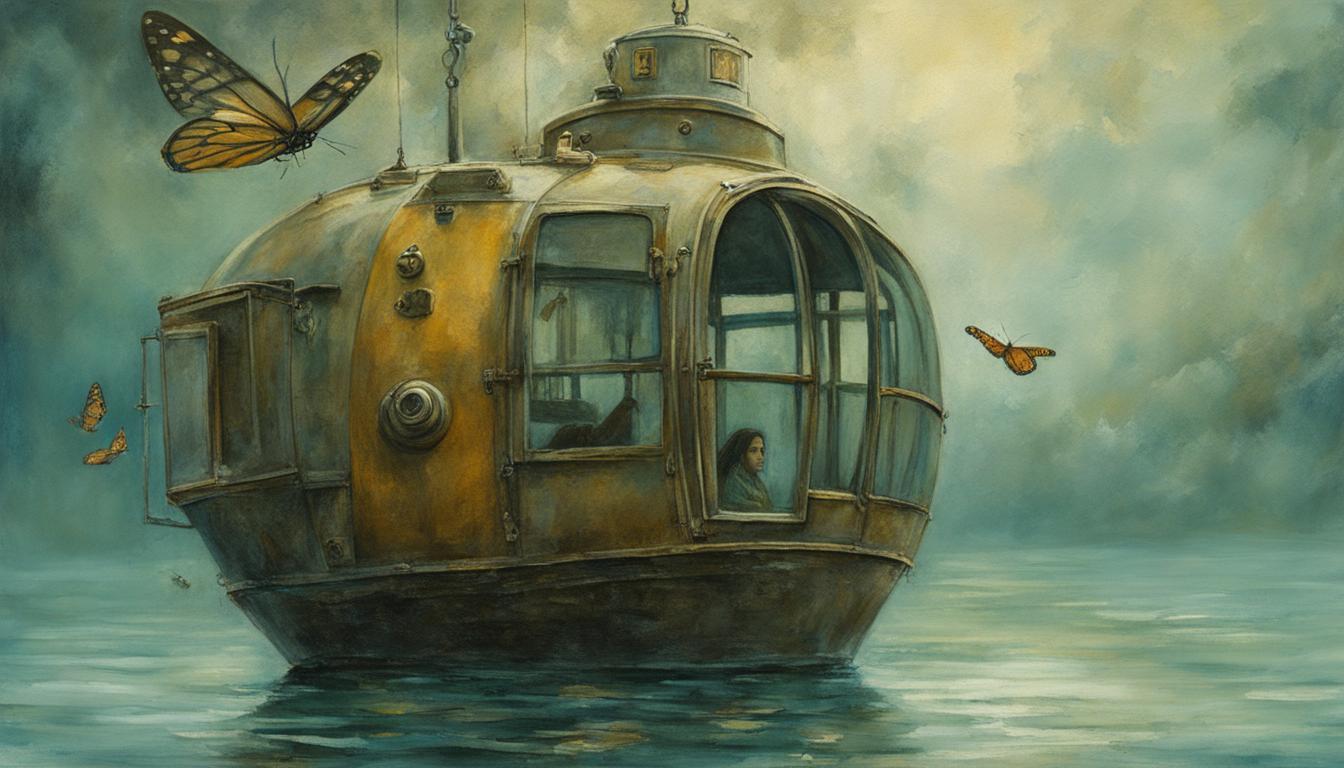In the landscape of profound literature, the memoir of Jean-Dominique Bauby stands as a towering beacon of resilience and the extraordinary capabilities of the human spirit. “The Diving Bell and the Butterfly” is not only a testament to Bauby’s indomitable will but also a journey into the heart of a life beset by the trials of Locked-in syndrome. This text seeks to peel back the layers of Bauby’s experiences, examining the creation of his stirring narrative, and unveiling the broader themes of hope that resonate through his words.
Bauby’s memoir allows readers a visceral glimpse into a reality where the physical form is immensely constrained, yet the mind continues to soar unrestricted. This exploration aims to honor the legacy of a man who, despite being locked within himself, expanded the world’s understanding of inner strength and the unyielding human desire to connect and communicate.
An Introduction to “The Diving Bell and the Butterfly”
The heart-rending and remarkable journey of Jean-Dominique Bauby, chronicled in his influential French memoir, “The Diving Bell and the Butterfly,” stands as a testament to the resilience of the human spirit in the face of overwhelming adversity. This inspiring book, penned by the one-time illustrious editor-in-chief of French Elle magazine, unfolds the visceral reality of Bauby’s life post-stroke that left him with Locked-in syndrome—an affliction that traps the cognitive mind in a nearly unresponsive body.
Against the stark backdrop of this life-altering condition, Jean-Dominique Bauby’s memoir emerges as a beacon of determination and creativity. It’s a story not only of enduring life’s challenges but of redefining the possibilities of communication and expression. Bauby’s narrative journey from celebrated journalist to a man locked within his own body, who then transcends his physical constraints through the power of storytelling, is one that continues to inspire and move readers globally.
This memoir’s creation is a result of an extraordinary partnership between Bauby and his speech therapist. He dictated each passage solely by blinking his left eyelid, choosing letters from a frequency-ordered alphabet. Through this painstaking process, Bauby delivered a profound narrative full of depth and introspection despite his inability to speak or write in traditional ways.
Here are some of the significant themes that Bauby’s story encapsulates, highlighting the core elements that make “The Diving Bell and the Butterfly” an enduring piece of literary work:
- The depiction of sheer human willpower in the face of incapacitating physical limitations
- The exploration of inner life and the expansiveness of human imagination
- An intimate narrative that gracefully balances sorrow with wry humor
- A fascinating account that opens a window into a rare condition, bringing awareness and empathy
- Reflections on the essence of communication, memory, and identity
From the hauntingly beautiful opening that compares his paralyzed body to a heavy diving bell, to the flights of freedom represented by the butterfly, Bauby’s memoir is more than a book—it is a journey, an experience, and a legacy that continues to be an emblem of hope and imagination transcending the confines of physical being.
The Unique Format of Bauby’s Memoir
The memoir of Jean-Dominique Bauby, “The Diving Bell and the Butterfly,” stands as a monumental achievement in literature, not only for its profound content but for the extraordinary method in which it was written. Stricken with Locked-in syndrome, Bauby’s only means of interaction with the world was through the flutter of an eyelid—an incredibly limited form of communication that did not hinder him from penning one of the most unique memoirs in modern times.
Composing Through Blinking
Trapped within his own body, Bauby’s locked-in state required an alternative means of expression. With the devoted help of a transcription assistant who recited a frequency-ordered alphabet, Bauby was able to blink at the letters he needed, painstakingly spelling out each word of his memoir. This method of crafting a narrative, one blink at a time, underscores the profound determination he possessed to share his life and thoughts despite his physical limitations.
The Restrained Physicality of Expression
Embodying both the frustration and the tenacity of the human spirit, Bauby’s communication method was replete with challenges. Each word, each pause, and each sentence represented a Herculean effort amid the confines of paralysis. Yet, this restrained physicality led to a purity of expression that rendered Bauby’s insights all the more striking. The sheer effort required to convey his tale added a depth to his words that is rarely achieved in more conventionally penned memoirs.
Jean-Dominique Bauby’s Life Before Stroke
Before the stroke that radically altered his life and led to the writing of “The Diving Bell and the Butterfly”, Jean-Dominique Bauby was a commanding presence in French journalism. A man with a flourishing career, Bauby’s background was replete with accomplishments that secured his status as a high-profile editor. His ascent to the top of the literary and journalism world is a testament to his skill, tenacity, and visionary leadership.
Bauby’s tenure in the media industry was marked by a blend of acute insight and a palpable passion for storytelling. As the helm of the prestigious French Elle magazine, he influenced public opinion and fashion trends with an expert hand. His journey from a young writer to a leading figure in the editorial world lays down a narrative of personal and professional triumphs.
“To limit oneself merely to visible and quantifiable events would be to castrate reality, an absurdity to which scientist-philosophers, obsessed with sophistication, once white coats are off, would never agree.”
The remarkable trajectory of Bauby’s career is highlighted by key milestones that underscore his profound impact on the world of publishing and culture at large.
| Year | Position | Achievements |
|---|---|---|
| 1980 | Arts and Culture Reporter | Began career in journalism, displaying keen insight on cultural trends. |
| 1988 | Fashion Journalist | Brought fresh perspectives to fashion journalism, influencing European tastes. |
| 1994 | Editor-in-Chief, French Elle | Elevated the magazine’s influence; embraced innovative editorial strategies. |
| 1995 | Author and Contributor | Penned thought-provoking articles for various high-profile magazines. |
The foundation of Bauby’s remarkable achievements can be traced to his unique perspective on life, and his ability to capture the zeitgeist of the French intelligentsia. His background was not just a footnote to his momentous work, but the fertile ground upon which his monumental legacy was built.
Exploring the Book’s Themes and Symbolism
At the heart of Jean-Dominique Bauby’s “The Diving Bell and the Butterfly” lies a rich tapestry of personal memoir themes, deeply embedded literary symbolism, and profound psychological exploration. These elements interweave to present a memoir that is as complex and multifaceted as the human experience it depicts.
Confinement versus Freedom
The stark contrast between physical entrapment and the unbounded nature of the human mind is a central theme in Bauby’s memoir. Despite the constraints of his paralyzed body, Bauby’s spirit soars, exploring memories and fantasies with the same freedom that once characterized his physical life. This juxtaposition serves as a powerful form of literary symbolism, representing not only Bauby’s struggle but also the universal human condition.

Reflections on Memory and Identity
Memory and identity emerge as pivotal foundations upon which Bauby constructs his narrative. As he sifts through the remnants of his past, Bauby undergoes a psychological exploration, questioning the essence of self and how it persists when separated from the physical world. His reflections offer a window into the resilient core of human identity, perennially anchored in personal history and introspection.
“The identity within rejects the constraints as it embraces the richness of a remembered life.”
The Power of Imagination in the Face of Adversity
Amidst the tethering confines of his physical state, Jean-Dominique Bauby’s tale is a resounding testament to the power of the mind. His memoir, “The Diving Bell and the Butterfly”, is a narrative that delves deep into his psyche, revealing the astounding capacity for what could be termed a mental escape from his paralysis. The memoir does not merely chronicle Bauby’s everyday struggle with Locked-in syndrome; it epitomizes a remarkable journey through his vivid imagination, demonstrating his overcoming adversity with sheer mental fortitude.
The palpable strength that Bauby derives from his memories and fantasies is a rich field for discussion on the resilience of the human spirit. Without the ability to partake in the physical world, Bauby travels expansively through the realms of his mind. Here is a glimpse at how these mental explorations played a critical role in his extraordinary mental preservation and existential defiance against his physical limitations.
Imagination can take you anywhere, the past can be revisited, the future anticipated, and the most inaccessible places reachable.
One can argue that Bauby lived as much within his constructed realities as he did in the hospital room that defined his physical world. Below, we explore the elements that provided him pathways to liberation—a testament to the power imbued within the human psyche.
- Fantasies as Daydreams: Escapades in his mind that took him from the confining walls to exotic locations and scenarios.
- Memories as Time Travel: Recollections serving as a bridge to a life before his condition, a cherished reservoir from which he drew strength.
- Desires as Fuel: The dreams that maintained Bauby’s hope and enlightening moments of desire for the life he still cherished.
Each aspect conveys the remarkable patience and creativity with which Bauby approached each day. These mental exercises are not mere figments but lifelines that held his identity intact, perpetuating his inner voice despite external silence.
The following table showcases the two starkly contrasting worlds that Bauby inhabited—the confined physical and the boundless mental—drawing attention to how his mind’s eye served as his ultimate refuge.
| Physical Reality | Mental Escapism |
|---|---|
| Locked-in Syndrome | Liberty of Imagination |
| Dependence on Others for Communication | Autonomous Thought Process |
| Immobility of the Body | Unhindered Mental Voyages |
This bi-dimensional existence, as spelled out by Bauby, serves not just as a chronicle of his own journey but stands as a universal harbinger for hope. It underscores that the power of the mind to summon inner worlds can be as compelling as any tangible existence, especially when one’s physical world shrinks to the size of a hospital bed. Bauby’s ingenuity in the face of such extraordinary challenges sets an indelible mark on what it means to live beyond corporeal boundaries, ultimately granting him a timeless legacy in the annals of memoir literature.
Adaptation: From Page to Silver Screen
The transition from the introspective pages of “The Diving Bell and the Butterfly” to the dynamic medium of film posed a significant challenge: how to visually manifest the deeply private world of Jean-Dominique Bauby. A film adaptation requires not just a retelling, but a reinvention of storytelling techniques to achieve a cinematic portrayal that stays true to the spirit of the original memoir.
The Challenges of Adapting an Internal Monologue
To convert the internalized experience of Bauby into a format that could captivate a movie-going audience necessitated creative solutions. Bauby’s locked-in syndrome limited him to the smallest physical movements, yet his internal world was rich with thoughts and memories. The film adaptation had to devise strategies to communicate these complex mental processes, transitioning from the silent echoing thoughts of a man’s mind to the visual and auditory sphere of cinema.
Visual Storytelling Techniques
Successful film adaptation relies on harnessing the power of visual storytelling to translate non-visual experiences. Cinematic techniques such as point-of-view camera angles, tight close-ups, and visual effects were employed to grant viewers access to Bauby’s perspective. Narration overlaying scenes and the selective use of sound design further facilitated the delivery of Bauby’s interior monologue to audiences, bridging the gap between the page’s silent narrative and the film’s sensory world.
These approaches are not without risk, as they must balance the essence of Bauby’s experience with the innate demands of cinema—a medium characterized by its visual and temporal immediacy. The resulting film adaptation thus emerges as an artistic interpretation, a secondary text that resonates with the original yet stands on its own as a work of visual art.
Critical Reception of Bauby’s Work
The impact of “The Diving Bell and the Butterfly” has been profound within the literary community, resonating with readers and critics alike. Upon its release, the memoir garnered literary acclaim for its poignant and incisive exploration of the human condition. The fact that Jean-Dominique Bauby crafted such poignant prose with the blink of an eye, following his cataclysmic stroke, infused the narrative with a deeper import, earning the book glowing reviews from numerous respected publications.
Critics have hailed Bauby’s memoir as a testament to the unyielding power of the human spirit. The memoir has been lauded for its eloquent and evocative language, which invites readers into the author’s internal world. The author impact is underscored by the international bestseller status of the book, as well as various prestigious accolades bestowed upon it. Below is a summary of the noteworthiness and recognition Bauby’s work has achieved in the literary sphere.
The memoir stands as an extraordinary achievement in literature — a beacon of creativity and determination that has inspired both readers and writers globally. – New York Times Book Review
| Awards | Year | Description |
|---|---|---|
| Prix Elle | 1997 | Given by the readers of Elle magazine, recognizing the memoir’s emotional power and literary finesse. |
| Legion of Honour | 1997 | France’s highest decoration was awarded posthumously in recognition of Bauby’s contributions to French literature. |
In addition to critical praise, book reviews from readers have often emphasized the inspirational aspect of Bauby’s story, with many reflecting on the memoir’s capacity to alter one’s perspective on life, disability, and the strength of will. The book has thus established a lasting legacy, both as a piece of high literary art and as a source of motivation for individuals facing their own adversities.
Analyzing Bauby’s Writing Style
When delving into the literary artistry of Jean-Dominique Bauby’s The Diving Bell and the Butterfly, one must consider the extraordinary conditions under which the memoir was crafted. His eloquent and evocative narrative emerges not from the free flow of pen on paper, but from the relentless blinking of an eye. This exploration of Bauby’s writing style reveals a mastery of language that establishes his memoir as a testament to the unconquerable human spirit.
Poetic Prose and Vivid Descriptions
Bauby’s prose conveys a poetic writing quality, marked by a rhythm and imagery that transcends the physical limitations imposed by Locked-in syndrome. The juxtaposition of his vibrant imagination with the stark reality of his condition creates a compelling contrast, one that is deeply moving and profoundly inspirational. A closer literary analysis unveils how the minimalist communication method only served to distill his words into pure expressive art.
A Narrative Journey of Inner Thoughts
Within the confines of his motionless existence, Bauby’s narrative style offers readers a deeply personal gateway into his innermost reflections. His narrative navigates through the landscapes of his memories, dreams, and desires, guiding the audience on an unforgettable emotional and intellectual journey that is both intimate and universal in its appeal.

Examining specific textual elements of The Diving Bell and the Butterfly, the following table breaks down the aspects of Bauby’s style that contribute to its power and resonance:
| Quality | Description | Impact |
|---|---|---|
| Imagery | Rich visual descriptions that evoke vivid mental pictures. | Engages the reader’s imagination, allowing them to visually experience Bauby’s recollections. |
| Motif | Recurring themes of the ocean, freedom, and flight. | Cultivates a deeper thematic meaning, reflecting Bauby’s longing and the human desire for liberty. |
| Tone | Melancholic yet infused with resilience and hope. | Connects with the reader on an emotional level, inspiring a sense of solidarity and empathy. |
| Pace | A deliberate, rhythmic pacing that reflects his method of communication. | Allows the reader to feel the weight of each word, emphasizing the depth behind them. |
Audiobook Review: The Enhanced Experience of “The Diving Bell and the Butterfly”
The transition of Jean-Dominique Bauby’s memoir from the printed page to an audiobook format offers a distinct and profound listening experience. This audiobook review delves into how the vocal nuances and pacing of the narrator serve to heighten the emotional layers of Bauby’s powerful storytelling. Because every spoken word carries Bauby’s legacy, the audiobook becomes an immersive journey through his remarkable life.
The Impact of Narration on the Story
In this audiobook review, it becomes clear that the narration adds a resonant depth to Bauby’s narrative. The listener is transported into the very essence of his experiences, not just through the words, but through the tone, inflection, and pauses that the narrator expertly employs. This storytelling device amplifies the intimacy between author and audience, creating a unique bond that is perhaps less tangible in the written word.
How the Audiobook Complements Bauby’s Writing
Furthermore, the auditory nature of the memoir allows Bauby’s crisp and poignant writing to be experienced in a way that many readers claim mirrors the internal dialogue of their own reading process. The seamless alignment between Bauby’s expressive literary style and the auditory delivery enriches the storytelling and enhances the overall engagement with the text. Listeners are offered an unparalleled journey into the profound depths of Bauby’s introspective and almost poetic prose.
| Feature | Impact on Audiobook Experience |
|---|---|
| Emotional Tone | A narrator’s ability to convey complex emotions enriches the narrative’s impact. |
| Character Voices | Differentiates characters and adds to the storytelling depth. |
| Timing and Pacing | Affects the tension and release of the narrative, guiding the listener’s emotional journey. |
| Auditory Details | Conveys the nuances of Bauby’s experience, enhancing the sensory element of storytelling. |
The audiobook version of “The Diving Bell and the Butterfly” not only offers an alternative means to consume Bauby’s stirring memoir but augments it by providing a richly textured listening experience. It stands as a testament to the power of storytelling and the extraordinary possibilities that arise when a story is shared through the spoken word.
The Role of the Butterfly: Hope and Transformation
In “The Diving Bell and the Butterfly,” the delicate creature with iridescent wings emerges as a potent symbol of hope and metamorphosis, mirroring Jean-Dominique Bauby’s remarkable journey of personal transformation. Within the pages of his memoir, the butterfly serves not just as an emblem of Bauby’s liberation from his physical constraints but also illustrates the capacity for rebirth amid life’s harshest trials.
The contrast between the confining diving bell and the liberating butterfly lies at the heart of Bauby’s narrative, casting a bright light on the profound dichotomy of his existence. Post-stroke, while his physical state seemed imprisoned, akin to the oppressive and heavy diving bell, his mind and soul embodied the lightness and freedom of a butterfly, flitting about in realms unbound by physical limitations.
In essence, Jean-Dominique Bauby’s legacy imparts the message that the human spirit is indomitable, often finding its wings—its hope and purpose—even in the abyss of despair.
Let’s explore the underlying motifs that align with the image of the butterfly in the context of Bauby’s life, as interpreted through the following representations:
- The Butterfly as a Symbol of the Soul -Historically, butterflies have been associated with the soul’s journey. In Bauby’s case, it manifested as an escape from a paralytic body, soaring towards creative and emotional fulfillment.
- Renewal after Tribulation – A butterfly’s metamorphosis parallels Bauby’s cognitive resurrection, creatively flourishing despite immense adversity.
- Endurance and Adaptability – The life cycle of a butterfly, with its stages and transformations, reflects Bauby’s enduring adaptability to a new mode of existence and communication.
When we consider Bauby’s legacy, it extends beyond the confines of his own narrative to inspire countless others facing their battles with adversity. It propagates the belief that, like a butterfly, one has the potential to rise and evolve through sheer resilience and willpower, thereby igniting a beacon of hope for others.
Comparing “The Diving Bell and the Butterfly” to Other Memoirs
Exploring the diverse terrain of the memoir genre reveals a rich tapestry of personal experiences, each offering a unique window into the human condition. Jean-Dominique Bauby’s “The Diving Bell and the Butterfly” stands out for its portrayal of resilience and the unconquerable nature of the human spirit. This section delves deep into memoir comparisons, specifically focusing on illness narratives, as we conduct a meticulous genre analysis to contextualize Bauby’s masterwork alongside others of its kind.
Examining the Memoir Genre
The memoir genre is a vessel for intimate self-expression and reflection. It allows writers like Bauby to document and share their battles and triumphs. While each memoir presents its distinct tale and thematic elements, common threads of perseverance and self-discovery often connect them. An in-depth genre analysis underlines the ability of memoirs to serve as both a mirror and a map, reflecting individual experiences and guiding others through similar challenges.
Stories of Illness and Recovery Narratives
“The Diving Bell and the Butterfly” invites readers to delve into the depths of human endurance in the face of debilitating illness. This memoir is often juxtaposed against other poignant illness narratives that recount personal journeys of struggle, healing, and sometimes, acceptance. Recovery narratives inspire, embolden, and offer solace by charting paths through illness that illuminate the enduring will to survive. Through these deeply human stories, memoirs become beacons of hope and insight for readers worldwide.
| Title | Author | Condition Explored | Year Published | Impact on Literature |
|---|---|---|---|---|
| The Diving Bell and the Butterfly | Jean-Dominique Bauby | Locked-in syndrome | 1997 | Expanded the memoir genre with a unique narrative technique and profound introspection. |
| Tuesdays with Morrie | Mitch Albom | ALS (Lou Gehrig’s Disease) | 1997 | Offered life lessons and wisdom about living through the lens of terminal illness. |
| Brain on Fire: My Month of Madness | Susannah Cahalan | Anti-NMDA receptor encephalitis | 2012 | Shed light on a rare autoimmune disease and the journey of rediscovery. |
| The Year of Magical Thinking | Joan Didion | Grief and mourning | 2005 | Explored the harrowing process of grieving and emotional survival. |
| When Breath Becomes Air | Paul Kalanithi | Lung cancer | 2016 | Reflected on life and death from the dual perspective of doctor and patient. |
Conclusion
Through this exploration of “The Diving Bell and the Butterfly”, we’ve uncovered the multi-dimensional nature of Jean-Dominique Bauby’s poignant memoir. As we’ve delved into his personal battle with Locked-in syndrome, his narrative has served to illuminate the resilience inherent in the human spirit. Through his unique storytelling, Bauby imparts a literary reflection on life, identity, and the unyielding will to communicate, even from the depths of physical confinement.
Bauby’s message resonates with a timeless echo, as it reflects on both the fragility and the endurance of the human condition. The significance of his memoir extends far beyond the literary community; it touches the core of our existence by showcasing the formidable potency of hope and imagination as tools of survival and as mediums for transcendence over life’s most harrowing obstacles. His life’s work, dictated one blink at a time, stands testament to our capacity for adaptation and the pursuit of meaning amidst adversity.
In closing, Jean-Dominique Bauby’s “The Diving Bell and the Butterfly” not only carves an indelible mark on memoir literature but also leaves a powerful legacy that continues to inspire and challenge readers worldwide. The memoir’s significance has clearly transcended the realm of literature, fostering profound reflections upon the very essence of what it means to live and to dream against all odds.



